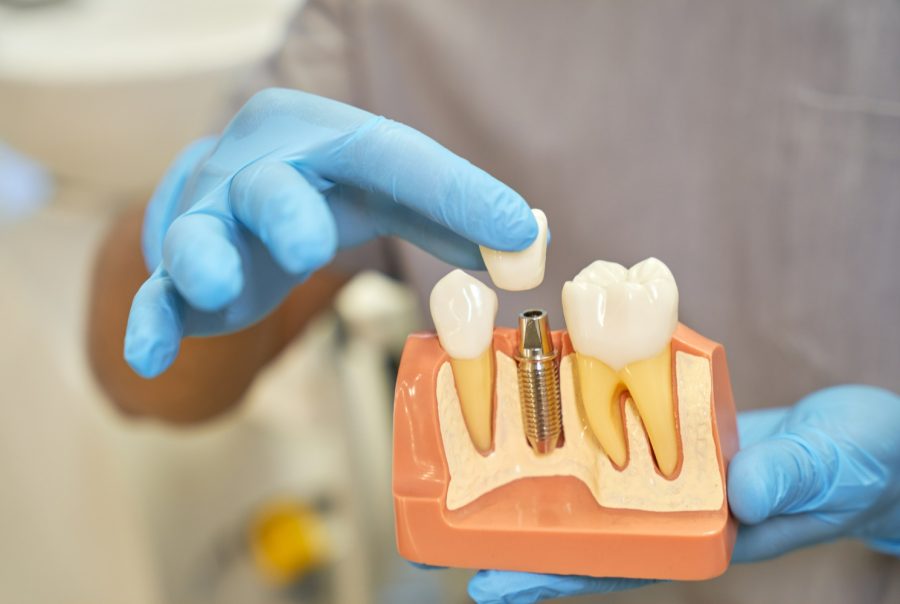Get information about inlay-onlay tooth restoration treatment with the detailed explanation of specialist dentist Seher Arseven.
Inlays & Onlays

Inlays & Onlays Turkey, Antalya.
Inlay and onlay fillings are aesthetic and durable restoration methods used in dentistry to repair decayed or damaged parts of teeth. They are preferred over traditional fillings due to their longer lifespan and natural appearance.
What is Inlay – Onlay Filling Treatment?
An inlay filling fills the spaces between the cusps (protrusions) on the chewing surface of a tooth, typically applied for smaller damages. An onlay filling, however, covers a broader area, including one or more cusps, making it suitable for larger cavities or fractures.
How is Inlay – Onlay Filling Treatment Performed?
The inlay and onlay filling procedure is completed in two sessions:
First Session:
- Local Anesthesia: Local anesthesia is administered to ensure you don’t feel any pain during the procedure.
- Cleaning: The decayed or damaged part is carefully cleaned and prepared for the filling. This involves working on the problematic area without damaging the tooth’s structure.
- Taking Measurements: Precise measurements of the tooth are taken. These measurements are used to create a custom filling in the lab. The impression can be taken using traditional methods (impression trays and putty) or digital scanners.
- Temporary Filling: After taking the impression, the cavity is covered with a temporary filling material, which provides aesthetic appearance and reduces sensitivity.
Second Session:
- Removing Temporary Filling: The temporary filling is carefully removed.
- Placing Inlay/Onlay: The custom-made inlay or onlay filling is placed in the cavity using special dental adhesives (dental cements). The filling is perfectly adjusted to fit the tooth.
- Adjustments: Necessary adjustments are made to ensure proper bite and chewing function. The surface is polished to achieve a natural tooth appearance.
In some cases, particularly for small inlay fillings, the entire procedure can be completed in a single session. In this scenario, the filling is directly shaped and hardened on the tooth. The use of digital impressions and CAD/CAM technology allows for faster and more precise filling production.
Materials Used in Inlay – Onlay Filling Treatment
Inlay and onlay fillings are made from materials that closely resemble the natural structure and appearance of teeth. The primary materials used are:
Porcelain:
- Aesthetic: Offers a color and translucency that closely matches natural teeth, providing a highly natural look.
- Durability: Highly resistant to wear and staining, maintaining its aesthetic appearance for many years.
- Biocompatibility: Compatible with body tissues, posing minimal risk of allergic reactions.
Composite Resin:
- Aesthetic: Available in different shades matching the tooth color, though it may not provide the same translucency as porcelain.
- Cost: More economical compared to porcelain.
- Single-Session Application: Does not require a lab process, can be prepared and applied in a single session.
- Durability: Though not as wear-resistant as porcelain, advanced composite resins can offer considerable durability.
The choice of filling material depends on the patient’s needs, budget, and the dentist’s recommendations. For aesthetic priority, porcelain or zirconium may be preferred. If cost is a concern, composite resin is a suitable option.
Who Should Get Inlay – Onlay Filling Treatment?
Inlay or onlay fillings are generally recommended in the following situations:
- Large Cavities or Damaged Teeth: In cases where traditional fillings are insufficient, i.e., when decay or damage affects a large portion of the tooth, inlay or onlay fillings are preferred. They effectively restore large cavities or fractures, particularly in molars and premolars, which are essential for chewing function.
- Aesthetic Concerns: Inlay or onlay fillings are ideal for front teeth where aesthetics is a concern. They provide a natural look due to their color matching with natural teeth. They are also useful in replacing old fillings that have discolored or worn out, offering a more aesthetic result.
- Teeth Grinding or Clenching Problems: Patients with bruxism (teeth grinding or clenching) exert excessive force on their teeth, causing traditional fillings to wear down or break faster. Inlay and onlay fillings are more durable, making them suitable for individuals with bruxism.
Inlay – Onlay Filling Treatment Costs
The cost of inlay and onlay fillings in Turkey varies based on several factors. For accurate pricing, it is best to consult your dentist, who will evaluate your teeth and provide a personalized treatment plan and cost estimate during your examination.
While inlay and onlay fillings may be more expensive than traditional fillings, their durability and aesthetic benefits make them a more advantageous long-term option. It is advisable to get quotes from different polyclinics to find the most suitable option for your budget.
Differences, Advantages, and Disadvantages of Inlay and Onlay Fillings
Inlay and onlay fillings are effective and aesthetic solutions for repairing decayed or damaged teeth. They differ in the area they cover and their intended use.
Inlay Fillings:
Inlay fillings are ideal for filling small to medium-sized cavities on the chewing surface of a tooth.
Onlay Fillings:
Onlay fillings cover a larger area, including the tooth’s cusps, and are used for repairing more extensive damage.
Both inlay and onlay fillings offer several advantages over traditional fillings:
- Made from durable and aesthetic materials like porcelain or composite resin.
- Mimic the appearance of natural teeth, enhancing your smile.
- Better fit the natural structure of the tooth, improving chewing function.
- Longer lifespan due to their durability, preventing further tooth wear.
However, inlay and onlay fillings are more expensive than traditional fillings and may require two sessions. In some cases, more tooth structure may need to be removed for the filling. Additionally, composite resin fillings may not be as durable as porcelain fillings and can discolor over time.
Lifespan of Inlay and Onlay Fillings
The lifespan of inlay and onlay fillings is significantly longer than traditional fillings. With proper care and regular check-ups, these fillings can last 10 to 15 years, and in some cases, over 20 years. However, several factors affect their longevity:
- Material: Porcelain is the longest-lasting filling material, offering high durability against wear and breakage. Composite resin, while less durable than porcelain, can still provide significant longevity, especially with advancements in resin technology.
- Oral Hygiene: Maintaining good oral hygiene, including regular brushing, flossing, and using mouthwash, prolongs the lifespan of fillings. Poor oral hygiene can lead to decay around the filling, reducing its lifespan.
- Teeth Grinding and Clenching: Bruxism can cause fillings to wear down or break faster. Therefore, treating bruxism can help extend the lifespan of the filling. Using a night guard reduces wear from teeth grinding and clenching.
- Regular Dental Check-Ups: Regular dental check-ups are crucial for monitoring the condition of fillings and identifying potential issues early. Early detection allows for quick and easy resolution, preserving the longevity of the filling.
The lifespan of inlay and onlay fillings depends on the material used, oral hygiene, teeth grinding habits, and regular dental check-ups. By paying attention to these factors, you can use your fillings healthily for many years.
Seher Arseven
She graduated from Hacettepe University Faculty of Dentistry in 2016. Between 2016 and 2018, she worked at Liv Hospital. After completing a six-year training program at Gazi University Faculty of Dentistry, Department of Periodontology, she obtained her PhD. She specializes in aesthetic gingival surgeries, the treatment of gingival recessions, and gingival diseases, with her thesis focusing on peri-implantitis and implant surgeries. She has numerous national and international publications related to peri-implantitis and implant treatments. Additionally, she is skilled in advanced bone surgeries.

